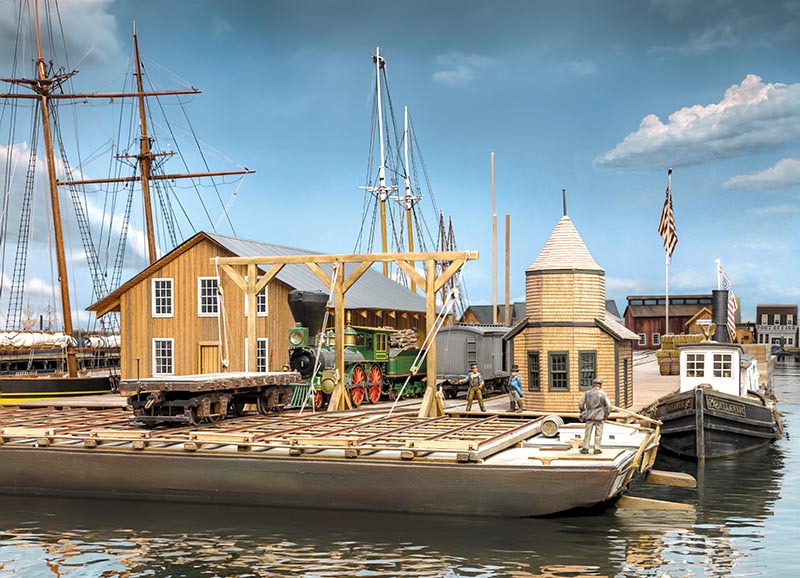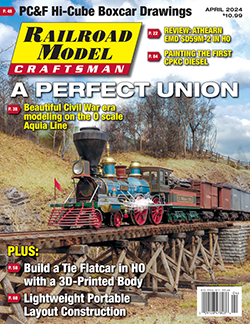 Bernard Kempinski, MMR/photos by the author
Bernard Kempinski, MMR/photos by the author
The United States Military Railroad (USMRR) Aquia Line, set in Virginia in March 1863 during the American Civil War, is an uncommon subject for a model railroad, one that to my knowledge has never been modeled before. Since 2009, I’ve been building an O scale layout with that theme. Despite the unusual subject and era, there are common aspects of the design and operation of my railroad that are applicable to any layout.
The first question you might ask is, why model a railroad set in the Civil War? I was born a New York yankee. The Civil War seemed like ancient history overshadowed by my parents’ experiences in the Great Depression and World War II. Their stories of those events sparked my interest in military history and modeling, especially armor and dioramas.
When I moved to Northern Virginia to begin a career in the defense industry after serving in the U.S. Army, I was surrounded by Civil War battlefields and I became interested in it.
As I researched the war, I learned more about the role railroads played in it. especially shaping strategy. It was in effect the first “railroad war.” Those railroads had interesting operations with busy schedules using early timetable and train order (TT/TO) control. In fact, railroads were still learning to perfect TT/TO, so the rules were few and simple, ideal for beginning operators to learn. The steam engines of this period were elegant, colorful, highly decorated, and had names and personality. Furthermore, railroad equipment in this era was smaller. A typical O scale 4-4-0 locomotive is about the same size as an HO scale six-axle diesel. The small equipment allows for sharper curves and compact design.
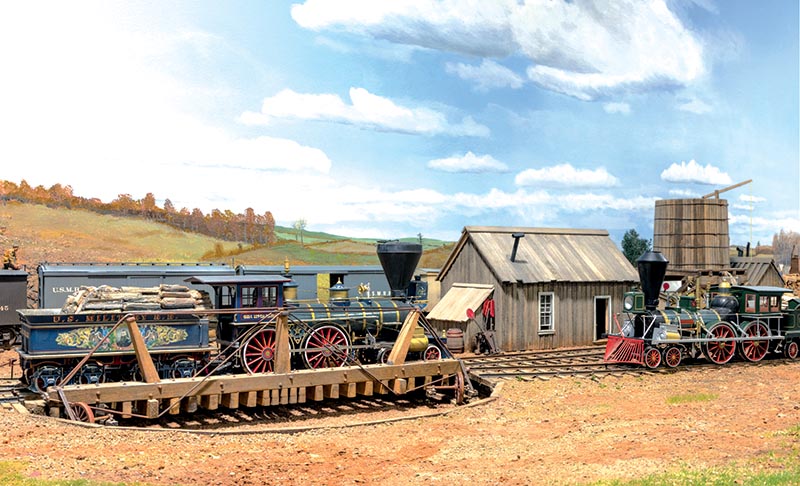
ABOVE: There was no turntable at Falmouth, but the author needed a way to reverse engines and there was no room for a wye. The design is based on the one used at Manassas, Va.
Background
The USMRR Aquia Line (pronounced uh-KWAI-uh) is essentially a short line, but there are some wrinkles and twists that make it interesting and unique. Before we discuss those, let’s set the stage with some historical background.
Virginia was a key theater during the war due to the proximity of Union and Confederate capitals. The Richmond, Fredericksburg & Potomac Railroad (now part of CSX) was right in the middle of much of the action.
Before the war, the RF&P ran from Richmond north to Fredericksburg, Va., across the Rappahannock River, and terminated at Aquia Landing on the Potomac River. The total distance was about 70 miles. At Aquia Landing, passengers and cargo transferred to steam ships to continue their journey to Washington, D.C., and points north.
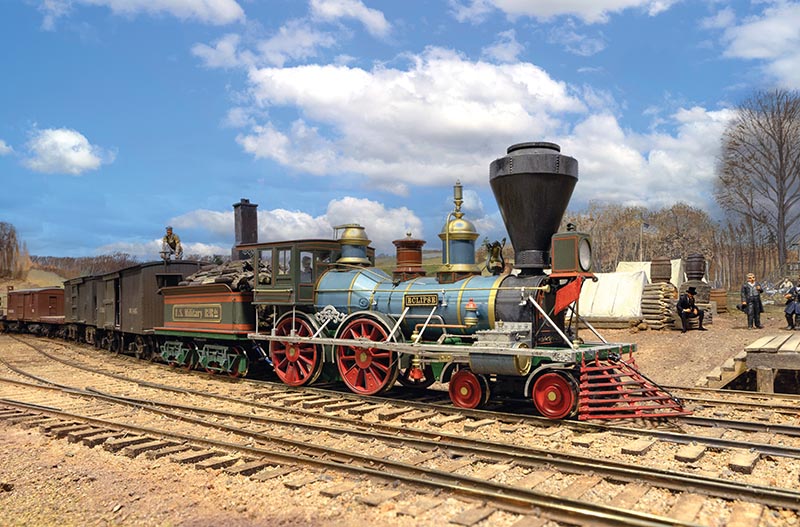
ABOVE: Engine “Eclipse” drifts into Falmouth with Train No. 5 consisting of a dozen loaded cars.
When the war started, this area was under Confederate control and the RF&P supported them. But, by 1862, the rebels abandoned this area and wrecked the northern part of the railroad as the fortunes of war moved south. The Union Army of the Potomac moved in.
The USMRR Construction Corps under command of then-Colonel Herman Haupt rebuilt Aquia Landing and about 20 miles of the railroad. The USMRR operated the Aquia Line to support the 110,000 men and 60,000 animals of the Army of the Potomac. Congress created the USMRR by the passage of the Railroad Act on January 31, 1862. This act allowed the Federal government to take over some railroads, mostly in the Rebel states as they came back under Union control. These captured lines were organized and run as a single entity, the USMRR.
The Battle of Fredericksburg in December 1862 resulted in a repulse for the Union Army of the Potomac. The Union forces withdrew to Falmouth on the north side of the Rappahannock River across from Fredericksburg. Rebel forces occupied the southern bank of the river. For the next six months the two armies encamped in those areas. There was very little fighting going on at this time. Both sides went into winter quarters to better survive the harsh weather that was colder and snowier than normal.
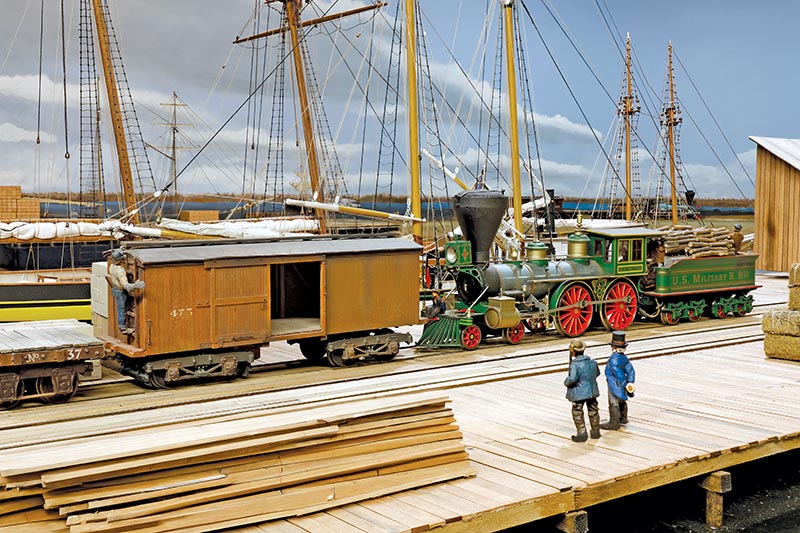
ABOVE: A view across the main wharf at Aquia Landing toward Burnside wharf illustrates the “forest of masts” effect the author is trying to capture.
Robert E. Lee, the Rebel commander, dispersed part of his army as far away as North Carolina to find food because the RF&P had difficulty supplying them near Fredericksburg and the local area had insufficient food for his men to forage. However, the Union Army remained in place because the Union quartermaster and USMRR Aquia Line kept them well-supplied with ample resources. Those supplies ranged from basic food items like hay for animals, hardtack and salt pork to luxury goods like canned fruit and lobster. The Union Army rebuilt its forces and prepared for more campaigns in the spring.
The Prototype
During this time the USMRR Aquia Line operated just 13 miles of the railroad as a typical short line using telegraph,TT&TO to control trains. The railroad transported food, supplies, and soldiers like any other railroad except that the military was its almost exclusive customer. The main exception was that the Adams Express Company did operate on this railroad. It was a private company that provided secure shipment of packages and money for the soldiers and their families. They had their own cars that the USMRR hauled, though evidence suggests that the Aquia Line also used regular USMRR boxcars to ship express packages.
The railroad had no land connection to the rest of the North. All incoming cargo had to be delivered by ship or barge to Aquia Landing. The Union Army built a large military depot with extensive wharves at Aquia Landing. Several warehouses serviced by two tracks lined the main wharf. The USMRR built a ramp to transfer cars from a car float to those tracks. That car float operation was the first ever of its kind. To construct the float the USMRR lashed two or three Schuylkill barges side-by-side and laid eight tracks across them. Once a day the USMRR would load the car float in Alexandria. Tugs would haul the float to Aquia Landing. It would return the same day. Col. Haupt claimed that the float could be unloaded and reloaded in about one hour. The USMRR added a second wharf about one mile downstream of Aquia Landing to accept deeper water ships. They called that Burnside’s Wharf, named after the commander of the Army at the time…


